The other day, I ran across a couple of interesting charts and decided to send them, without any context, on to an overseas colleague to solicit some analysis from him regarding what significance these charts might hold. Here are the two charts:
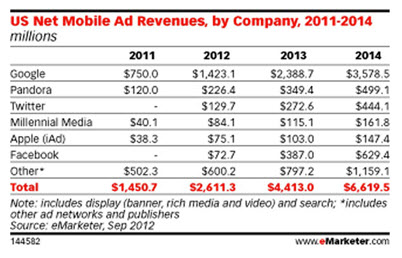 My colleague’s response was very swift, as well as utterly concise: “QCOM”.[1]
My colleague’s response was very swift, as well as utterly concise: “QCOM”.[1]
I confess that my “Quiz” was a complete and utter set-up.[2] My colleague is such a consistent and vocal advocate of the trading/investment virtues of QCOM that I would have been shocked had he replied with any other answer. Furthermore, knowing that he is an engineer by education, I suspect that (in his inner being) he is jealous of Irwin Jacobs’ great fortune in creating the Code Division Multiple Access (CDMA) technology that drives most mobile phone technology[3]; or perhaps he wishes he was sitting in Paul Jacobs’ chair – helping to drive technological progress around the world!
Of course, “everyone knows” that mobile is “the future” – a premise already borne out by untold sales charts demonstrating the steady decline of the PC and the unstoppable ascendancy of “mobile” through smartphones and tablets[4]. That is why almost every conversation regarding the future earnings of companies such as Facebook (FB), Twitter (TWTR), Google (GOOG), etc. includes at least one question regarding how the company is “monetizing mobile”.
Therefore, QCOM sits at the very “Nexus”[5] of modern technology in multiple ways! Not only does its CDMA technology “connect” each cell phone with a wireless tower (without which it won’t work), but QCOM technology also “connects” one cell phone user with another. And of course, QCOM technology “connects” a smartphone with the world through the Internet!
Therefore, it is worthwhile for you to know a bit about QCOM technology and about its business/financial model. One of the key technological advances by QCOM resulted in development of the Snapdragon S4 “System on a Chip” (SoC).
 The S4 offered multiple advances vis-à-vis its predecessors and competitors, including:
The S4 offered multiple advances vis-à-vis its predecessors and competitors, including:
1) The modem for cellular communication is directly “built-in”! This means that a separate, external cell modem on the printed circuit board is no longer required!
2) Other “on-die” features provided through the Snapdragon S4 include such options as Wi-Fi, GPS/GLONASE, and Bluetooth basebands.
These chip features have reduced the complexity and cost of smartphone production, and (perhaps even more significantly) cut down on both power demands and heat generation. This sort of technological advantage provides QCOM with obvious pluses, and (as a result) the “marketing light bulb” has lit at QCOM. QCOM Senior Director of Software Strategy and Business Development, Liat Ben-Zur, recently offered an interview regarding QCOM’s shift in strategy (actually, an expansion of focus). Formerly, QCOM concentrated its efforts upon manufacturers – sharing key aspects of QCOM technology. Now, QCOM is making a point to take its message (and tech such as the Snapdragon SDK for Android) directly to developers – knowing that its tech can inspire and enable much more powerful and feature-rich applications. It is within such future development of exciting and irresistible apps that QCOM sees its future as a “must have” technology! In Bun-Zur’s words:
“That’s the point I want to get to where you hang out with a buddy and you have a Snapdragon phone and he doesn’t and you both have the same app. When you use the app, you have extra options and features and your buddy starts wondering why he doesn’t have that. And the next time, he buys a Snapdragon phone!”
Ben-Zur went so far as to liken this new, more ambitious marketing approach to the classic Intel marketing tagline — “Intel Inside”! Doesn’t this general look (below) remind you of “Intel Inside”?
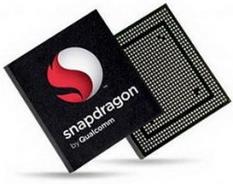 Along this line of thought, my research led me toward a very amusing (and somewhat entertaining) rap song video that touts Snapdragon as a key in improving one’s relationships! See: http://gigaom.com/2012/07/13/qualcomm-wants-to-sell-developers-consumers-on-snapdragon-inside/ [You need to scroll to the end of the link for the YouTube vid]
Along this line of thought, my research led me toward a very amusing (and somewhat entertaining) rap song video that touts Snapdragon as a key in improving one’s relationships! See: http://gigaom.com/2012/07/13/qualcomm-wants-to-sell-developers-consumers-on-snapdragon-inside/ [You need to scroll to the end of the link for the YouTube vid]
Let’s move on to the QCOM business/finance model. I find it both fascinating and ingenious. Take a look at this “Company at a Glance” slide on QCOM: [6]
As we have already reported, QCOM is a leading developer (as well as pioneer) of Code Division Multiple Access (CDMA)[7]. If you knew nothing about QCOM, you might easily expect that its largest source of revenue would be the direct sale of its chipsets (such as the Snapdragon) to smartphone makers. If so, you would be very mistaken! As you can see above, “Mobile Device Chipsets” account for only 26% of QCOM’s current value! Chipset customers include LG, [Nokia (NOK)], Motorola Mobility, [Samsung (SSNLF)], and [Apple (AAPL)].
In addition, QCOM licenses its CDMA technology to competitor chipset manufacturers. Therefore, QCOM has a lock on the revenue stream that comes from the sale of every cell phone chip that incorporates CDMA technology. That is pretty slick, isn’t it?!![8]
But it gets better! The essential genius within the QCOM business model is the royalty paid by mobile manufacturers on every device that incorporates QCOM chips and/or CDMA .The royalty is set as a percentage of the selling price of each such mobile device. As you could see above, these “royalties” account for nearly half of QCOM’s current value!
Have you caught on yet to the full significance of this finance/pricing model? QCOM sells chipsets directly and receives royalties on its technology; and (amazingly) is entitled to license fees from competitor chipmakers who utilize its chip technology, as well as a royalty on each phone sold that utilizes CDMA! [9]
From a disclosure point of view, it is advisable for me to insert just a brief word on QCOM competition. An overly simplified (but illustrative) view of the phone chip space is as follows: QCOM’s Snapdragon SoC is extensively used in Android-based smartphones, as well as Windows Mobile phones. Competitors of Snapdragon include the Exynos chip (Samsung), the Tegra processor [Nvidia (NVDA)] and the OMAP 4 chip [Texas Instruments (TXN)]. Among other phone platforms, iPhones use an A7 processor and Blackberry smartphones utilize T1 processors.
Despite periodic bouts with investor pessimism (you’ll soon see the degree to which QCOM has underperformed within the current bullish market), good news has been mounting for QCOM, including:
1) China, the world’s largest smartphone market, continues in its countrywide shift from 2G to 3G, which will inevitably enhance the QCOM revenue stream;
2) The most recent QCOM earnings report incorporated the full FY ended 9/30/13. From the presentation provided by management:
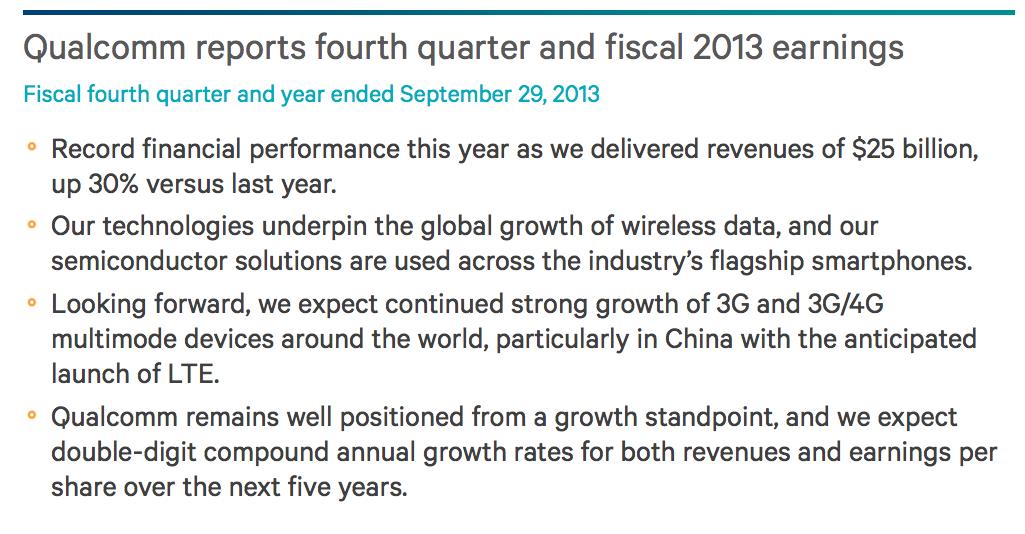
3) Consensus EPS estimates for FY 2014 were raised from $4.96 to $5.06.
4) Standard & Poor’s recently reiterated its “five-star strong buy rating”;
5) In addition, S&P lifted its 12-month price target from $85 to $90/share.
6) On Tuesday, November 12, QCOM crossed above its 50-day SMA;
7) On Wednesday, November 13, QCOM crossed above its 5-day EMA;
8) As you can see from the weekly price graph below, the price action last week was very strong:[10]
Surely by now you have become convinced of the many intrinsic virtues that compose the “fundamental” story behind QCOM! If that is true, then my overseas colleague is thrilled that you see what he sees!
Once again (as part of my “full disclosure”) there are some QCOM skeptics. One thing worrying folks has been the oft-repeated (but not necessarily true) premise that as the average price point of smartphones slides downward… the “gravy train” of royalty income that accrues to QCOM each year (described earlier) will inevitably diminish bit by bit. Now I ask you, should that be a huge “red flag”? Let’s think about that for a moment. Please answer this “Trivia Question”:
“What essential lesson from Economics 101 does the above bearish argument ignore?
Answer: The general economic rule is that as price declines, demand increases (the item becomes more affordable for a wider group of potential customers)!
BI Intelligence reports that, on a global basis, one in five cell phone users own a smart phone.[11] On that basis, one could reasonably assume that the market for smartphones is almost guaranteed to continue experiencing significant growth. In fact, industry authority Gartner estimates that production of smartphones is likely to increase approximately 60% between 2013 and 2016.
As an illustration of the rebuttal to the above “royalty problem (an bearish argument that I consider a “straw dog”) consider this summary of the market rationale behind the newest Motorola Mobility [12]smartphone – the Moto G that was announced just days ago. It will have a $179 price point, which is just one-third the price of the iPhone 5C! The reason it is priced so low is to entice buyers in overseas markets, where phones don’t benefit from the high cell service provider subsidies that have pampered U.S. customers. The Moto G is particularly directed toward customers in huge markets such as Brazil and India. [13]
Motorola’s marketing rationale was explained as follows by Chief Executive Dennis Woodside: “You don't have to get a lot to have some substantial change in trajectory for the top line and for the unit sales.” [14]
The basic premise here is (as BI Intelligence suggested) – lower the price point and raise the volume of sales!!
Now that I have eased your mind on that score, do you need anything else? Perhaps you are wondering: “Is QCOM a good value?”
You had better believe that it is!
There are many “value fund managers” in the world today, but few boost the credentials and record of someone like Bill Nygren, the lead manager at the venerable $11 billion “Oakmark Fund”.[15] Oakmark initiated a new position in QCOM during this past (third) quarter. Oakmark’s investment strategy involves buying a security when its price stands at a steep discount to the fund manager’s “intrinsic value”. This is what Nygren says about QCOM:
“Qualcomm’s licensing business accounts for only 1/3 of the company’s revenue, and it is often underappreciated However, its licensing business has unusually high profitability and represents close to 2/3’s of QCOM’s profits. The majority of the world’s mobile handset users are still using older 2G technology, which is not a focus area for QCOM, so when these customers upgrade to 3G and 4G, QCOM should be well-positioned to enjoy robust incremental revenue.” Other value managers have offered parallel analyses.[16]
In addition, the cash hoard that QCOM carries on its balance sheet ($6.68/share as seen below) helps to significantly improve the actual (cash adjusted) valuation of QCOM.[17]
It is safe to say that QCOM is a “reasonable value” investment/trade!
And lest you are still at all skeptical, take a look at these charts:
1) In the 2-year chart below, we can see QCOM (blue) price action compared with the S&P 500 Index (red), and Technology SPDR ETF (XLK) (green). QCOM has undershot the Index by over 15% and even underperformed the tech ETF by about 5%
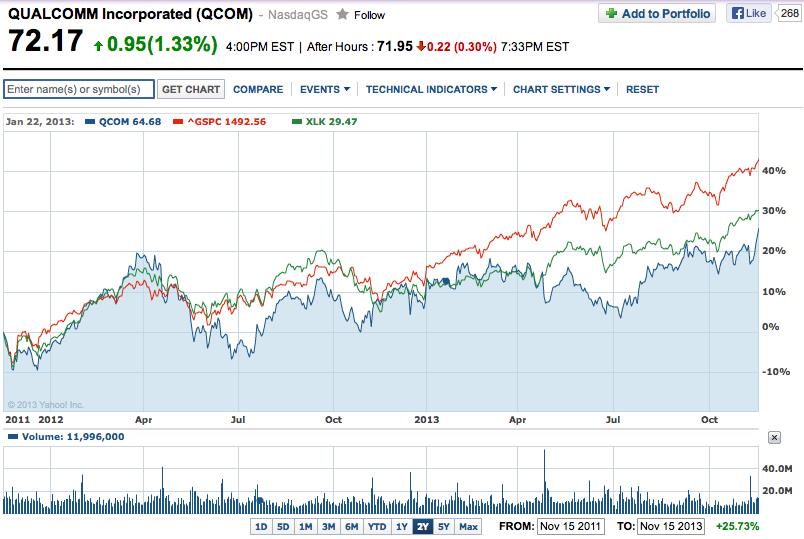
2) With regard to other big cap tech stocks, it is not surprising that QCOM underperformed GOOGLE (GOOG) (purple) and Amazon (AMZN) (reddish), but it might catch you by surprise that the margin of underperformance was in the 40% range.
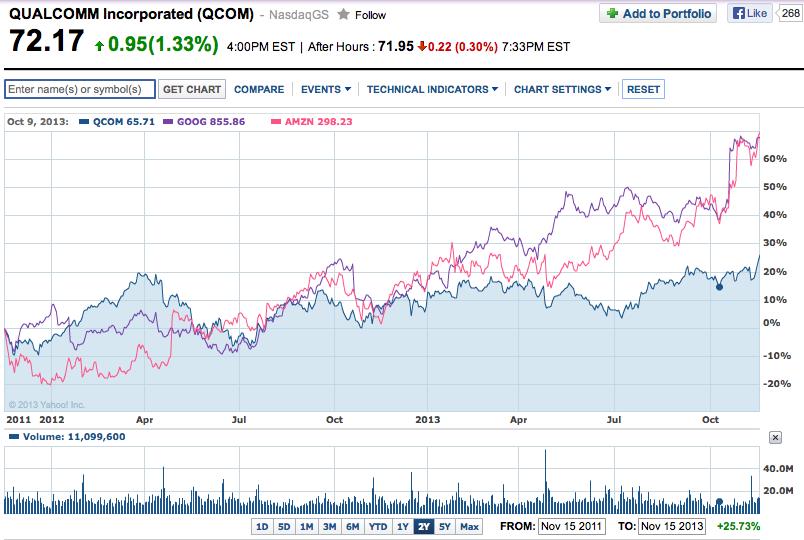
3) We all know what a weak two-year period Apple (AAPL) has had. As the next chart shows, QCOM even underperformed AAPL by over 10%!
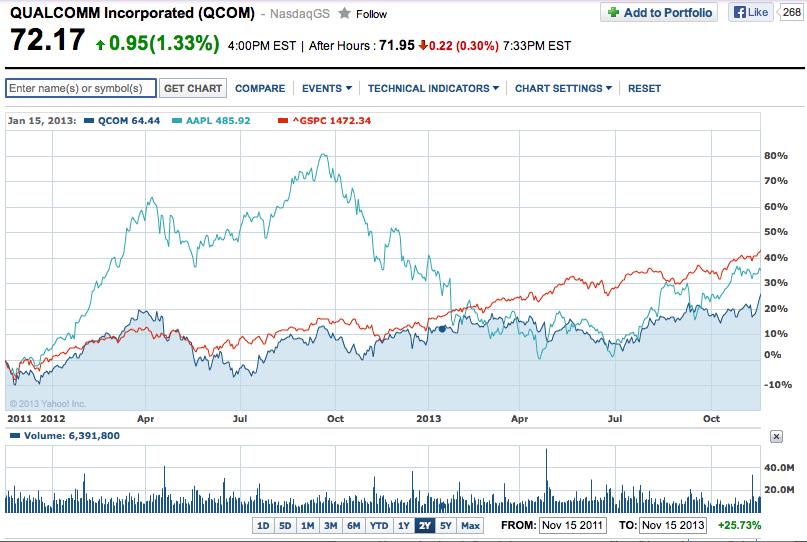
4) Finally, here are two “older line” tech companies that I contrast (below) with QCOM. The much-maligned Microsoft (MSFT) outperformed QCOM by over 15%, while only Intel (INTC) managed to be “shamed” by QCOM!
Can there be any doubt that QCOM has been underperforming the “market” as a whole, as well as stocks within its space, and yet its fundamentals, business plan, and metrics all demonstrate signs of strength, as well as prospects for better things to come?
INVESTOR TAKEAWAY: Wall Street “wisdom” often falls into many of the same traps that manifest themselves within the general realm of human discourse. Sometimes by chance, sometimes by the design (and/or manipulation) of one or more influential persons, humans sometimes adopt certain premises as a “truth” rather than as an “opinion”. When this happens, persons begin to draw conclusions and make decisions based upon “inputs” that (frequently) later prove to be mistaken.
It is such mistaken, misguided perceptions that “value managers” perpetually strive to uncover through their market analysis so their portfolio positions will (in the aggregate) outperform market benchmarks. That is a worthy objective for us, as well.
In case you haven’t yet “caught on” to the underlying premise of this article, both my colleague and I believe that the market currently undervalues QCOM!
DISCLOSURE: Do not forget something that I regularly point out in these articles. Namely, just because a security is undervalued, there is absolutely no guarantee that said security will not continue to remain undervalued!
The author has, in the past, owned stock in (or options on) QCOM, APPL, GOOG, INTC, MSFT, AMZN, etc. He currently own options on GOOG and AAPL, and intends to enter new positions in others in the days ahead. However, nothing in this article is intended to be a recommendation to buy or sell anything. Please consult with your financial advisor before adjusting your portfolio by buying or selling any security.
Submitted by Thomas Petty MBA CFP
[1] As 98.5% of you know, QCOM is the ticker symbol for Qualcomm Incorporated, a San Diego based company that is an international powerhouse within the smartphone technology/chipset market. Founders of Qualcomm were Irwin M. Jacobs and Andrew Viterbi in 1985 (so it is only 28 years old!). Currently, the CEO of QCOM is Irwin’s son, Paul E. Jacobs. The important thing about Paul is that he has earned his ascendancy to CEO through education (PhD) and enough industry experience to be valued as a respected leader in the mobile technology space.
[2] I confess to frequently being guilty of such shameless set-ups!
[3] CDMA facilitates communication between mobile devices and wireless towers.
[4] As well as the prospective growth of “Apple Watch”, “Google Glass”, and Lord knows what other products as yet dreamed up in some inventor’s imagination.
[5] “Nexus” means: “a means of connection; a link or tie; or a connected series or group. (My son thinks it applies to the name of the current Google tablet! Silly boy!)
[6] This comes from the ThinkorSwim trading platform.
[7] A mobile device technology that facilitates communication between mobile devices and wireless towers
[8] In addition, it has now moved into the very young femtocell market. I’d explain it to you, but it would take virtually half an article!
[9] QCOM also licenses OFDMA protocols on which LTE/WiMax technology is based.
[10] See the most recent week’s candle – straight up! The graph is created through the ThinkorSwim platform. The sole “study” showing here is the Ichimoku Cloud. Those familiar with “The Cloud” can recognize how bullish the pattern is.
[11] Several years ago, that statistic was one in 20!
[12] Remember that Motorola Mobility is owned by Google!
[13] However, the $179 price point could also conceivably entice budget conscious U.S. cell users.
[14] Woodside added some details: The Moto G lacks some of the high-end components found in the $549 unlocked version of the iPhone 5C or the roughly $600 Samsung Galaxy S4. But the Moto G's 4.5-inch touchscreen and 1.2-Gigahertz Qualcomm Snapdragon processor are leagues above what's available in other low-cost smartphones, which are often based on older technology.
[15] Oakmark Fund’s prior 5-year performance record exceeds that of the S&P 500 Index by about 4%per year (average).
[16] Manager David Rolfe has 6% of his fund’s assets in QCOM: “As the value proposition of smartphones become more attractive due to lower prices (compared to smartphone prices just a few years ago), we expect low priced feature phone subscribers will ultimately trade up to low end smartphones with higher ASP’s [average selling price; the basis of QCOM’s royalty] relative to their feature phone predecessors. In addition, given the highly commoditized nature of low end smartphones … we expect volume will closely offset, if not outpace average selling price declines.”
[17] In today/s market, hefty cash balances are common in the technology space. See my very recent article on that topic:
Related Posts
Also on Market Tamer…
Follow Us on Facebook

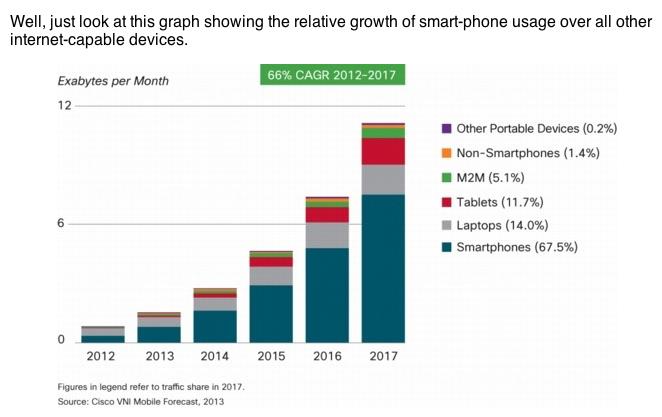
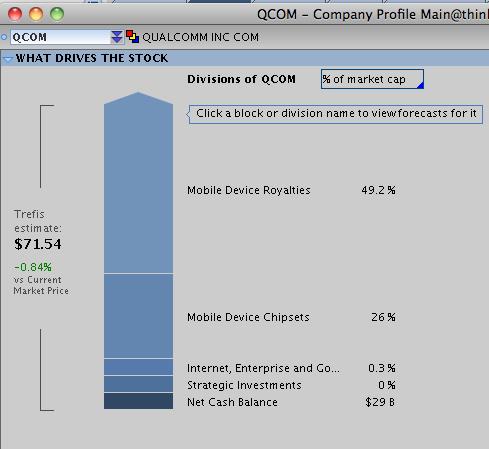
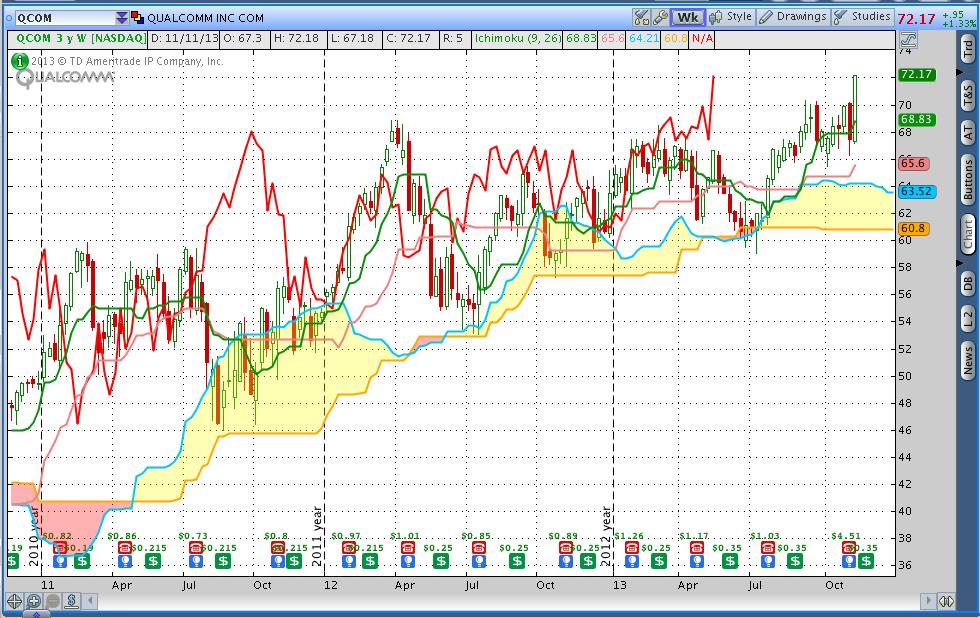

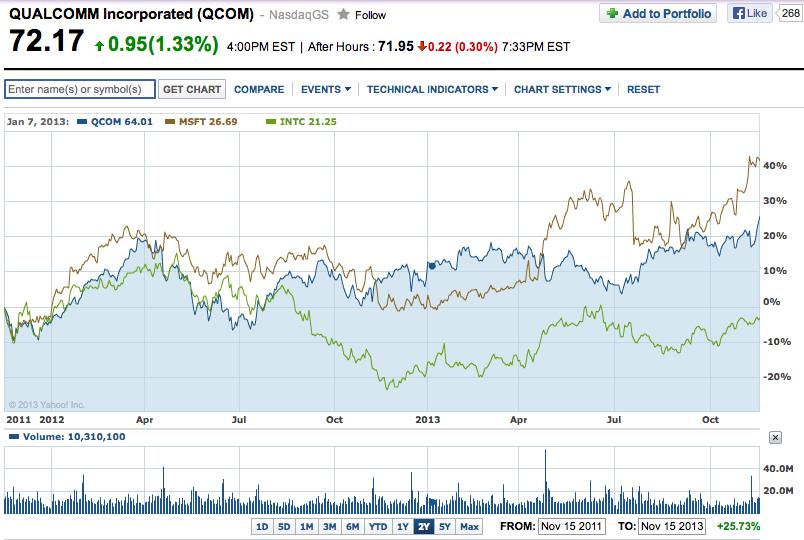
 3 High-Yield Stocks Beating the Market Slump That You Can Still Buy Hand Over Fist
3 High-Yield Stocks Beating the Market Slump That You Can Still Buy Hand Over Fist